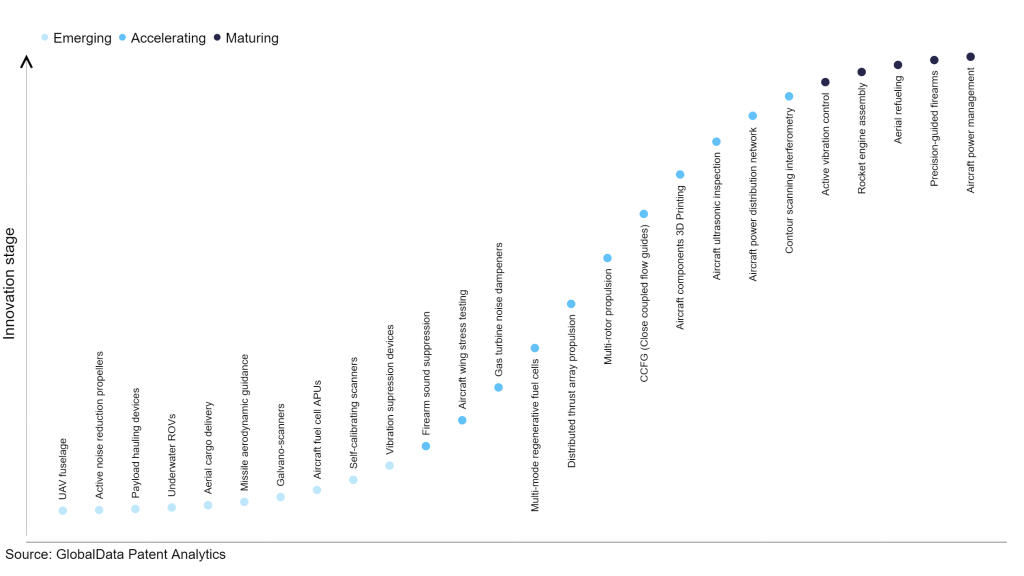The aerospace and defense industry continues to be a hotbed of patent innovation. Activity is driven by automation, environmental sustainability, and operational efficiency, and growing importance of technologies such as artificial intelligence (AI), Internet of Things (IoT), drones, and satellites. In the last three years alone, there have been over 237,000 patents filed and granted in the aerospace and defense industry, according to GlobalData’s report on Innovation in defense: multi-rotor propulsion. Buy the report here.
However, not all innovations are equal and nor do they follow a constant upward trend. Instead, their evolution takes the form of an S-shaped curve that reflects their typical lifecycle from early emergence to accelerating adoption, before finally stabilizing and reaching maturity.
Identifying where a particular innovation is on this journey, especially those that are in the emerging and accelerating stages, is essential for understanding their current level of adoption and the likely future trajectory and impact they will have.
110 innovations will shape the aerospace and defense industry
According to GlobalData’s Technology Foresights, which plots the S-curve for the aerospace and defense industry using innovation intensity models built on over 206,000 patents, there are 110 innovation areas that will shape the future of the industry.
Within the emerging innovation stage, aircraft fuel cell APUs, self-calibrating scanners, and vibration supression devices are disruptive technologies that are in the early stages of application and should be tracked closely. Aircraft ultrasonic inspection, aircraft power distribution network and contour scanning interferometry are some of the accelerating innovation areas, where adoption has been steadily increasing. Among maturing innovation areas are precision-guided firearms and aircraft power management, which are now well established in the industry.
Innovation S-curve for the aerospace and defense industry

Multi-rotor propulsion is a key innovation area in aerospace and defense
Multi-rotor propulsion refers to a propulsion system that utilizes multiple rotors to generate lift and control the movement of an aircraft. The aircraft is typically equipped with several motors and propellers arranged in a configuration that allows for vertical takeoff and landing and precise control in various flight directions. This propulsion system is commonly used in drones and unmanned aerial vehicles (UAVs) for various applications.
GlobalData’s analysis also uncovers the companies at the forefront of each innovation area and assesses the potential reach and impact of their patenting activity across different applications and geographies. According to GlobalData, there are 180+ companies, spanning technology vendors, established aerospace and defense companies, and up-and-coming start-ups engaged in the development and application of multi-rotor propulsion.
Key players in multi-rotor propulsion – a disruptive innovation in the aerospace and defense industry
‘Application diversity’ measures the number of applications identified for each patent. It broadly splits companies into either ‘niche’ or ‘diversified’ innovators.
‘Geographic reach’ refers to the number of countries each patent is registered in. It reflects the breadth of geographic application intended, ranging from ‘global’ to ‘local’.
Patent volumes related to multi-rotor propulsion
Source: GlobalData Patent Analytics
Boeing is one of the leading patent filers in multi-rotor propulsion. The company, through its subsidiary Aurora Flight Sciences, filed patents related to hybrid propulsion type vertical take-off and landing (VTOL) aircraft.
A hybrid propelled aircraft, having wings with ducted fans, uses both traditional and electric propulsion to take off and land vertically. The design of the aircraft helps it transition smoothly from vertical to horizontal flight without any sudden or unexpected movements. It also offers quick altitude transitions. The aircraft is more efficient during hover and forward flight compared to other VTOL aircraft and can also achieve a higher maximum speed when flying forward.
Boeing is working on the LIFT! Project to investigate the scaling of electric multi-rotor propulsion. It examined ways in which multiple VTOL aircraft could cooperate to decrease the cost of vertical flight.
Some other key patent filers in this space include Jetoptera, Airbus, and AeroVironment.
In terms of application diversity, Karem Aircraft, Textron, and Israel Aerospace Industries are some of the leading innovators. By means of geographic reach, some of the leading patent filers include Safran, Rolls-Royce, and VoltAero.
To further understand the key themes and technologies disrupting the aerospace and defense industry, access GlobalData’s latest thematic research report on Aerospace & Defense.
Data Insights
From

The gold standard of business intelligence.
Blending expert knowledge with cutting-edge technology, GlobalData’s unrivalled proprietary data will enable you to decode what’s happening in your market. You can make better informed decisions and gain a future-proof advantage over your competitors.



